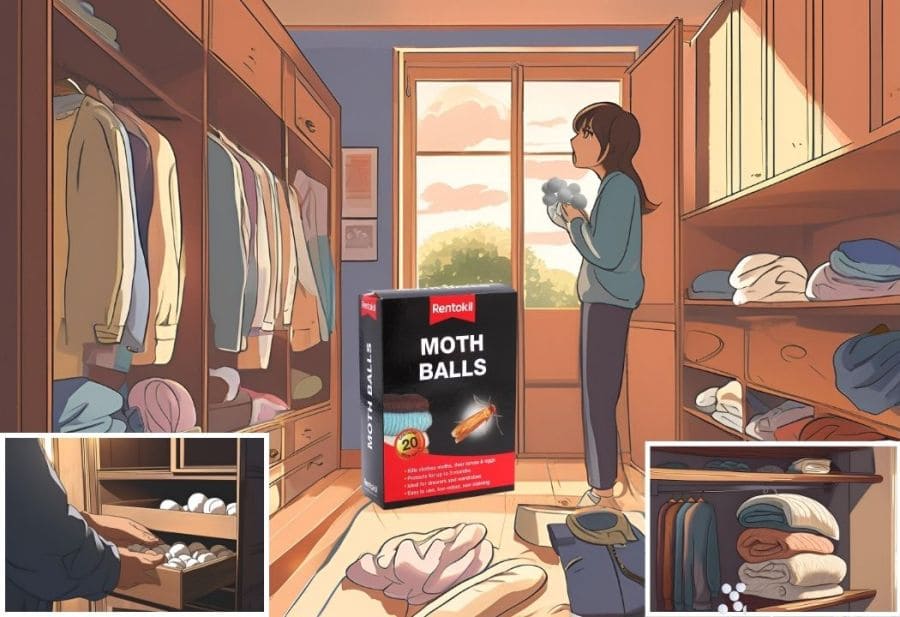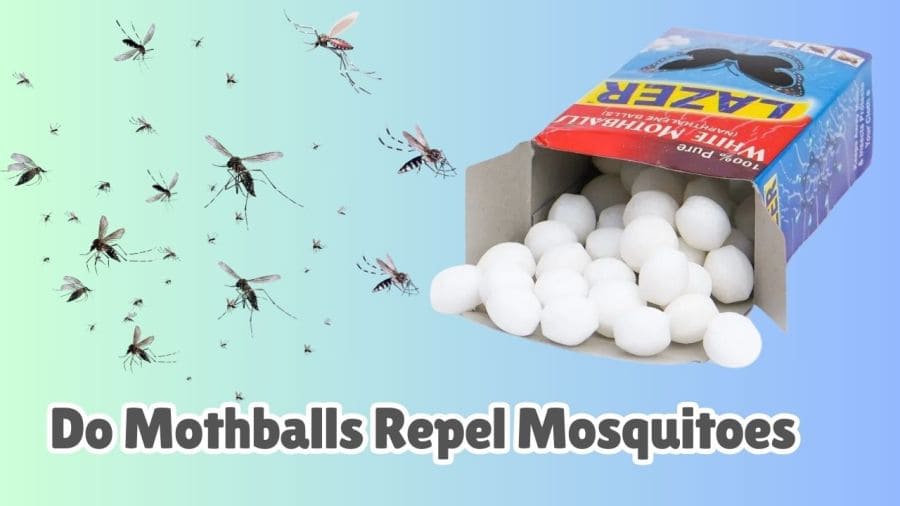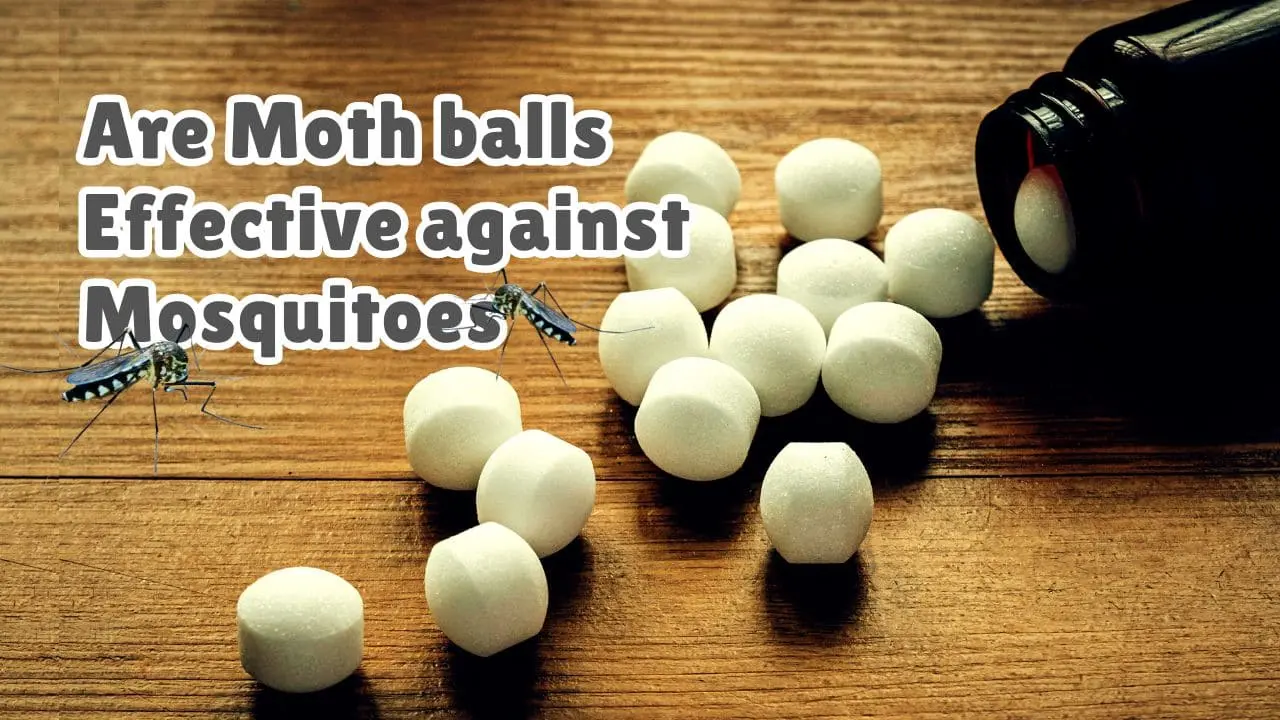Table of Contents
In our lifetime, we may have tried many remedies for keeping mosquitoes away. Have you tried mothballs or naphthalene balls? How do mothballs keep mosquitoes away? Typically as we all know, mothballs are known to repel moths, bugs and other insects from closed spaces like cabinets, cupboards, tables and wardrobes, etc.
Someone, spread the myth about mothballs as effective mosquito repellent. But what is the fact, do mothballs keep mosquitoes away? let us explore the truth and check the effectiveness and usability of mothballs as mosquito repellent.
What are Mothballs?
These are white balls or flakes made of naphthalene (volatile polycyclic hydrocarbon) or paradichlorobenzene, camphor, etc. and are primarily used to protect natural fibres like woollen and other clothing and textile items from molds, moths and certain insects.
They slowly and gradually releases a very sharp and strong pungent odor that repels the moths and insects away. However, the smell get also trapped inside the fibres of the clothing which sometimes not desirable.
Th U.S. Environmental Protection Agency (EPA) has regulated the usage of naphthalene balls and only to be used as specified on the label. These naphthalene balls are mistakenly or inappropriately misused at outdoor spaces to deter snakes, rats, squirrels and other critters.
This is mainly because some snake and animal, critter repellent products available in market do contain naphthalene, but their use for such purposes are not approved and encouraged in any manner.
How mothballs repel moths and insects?
Mothballs, also called as “naphthalene balls” or “naphtha balls” are very good bug and insect repellent specially moths. They evaporate and releases vapour in the air with a strong pungent smell that is nearly toxic for bugs, moths and some insects.
This vapor fumes accumulates in enclosed spaces like cupboards, storage cabinets, closets, etc. and becomes concentrated enough to cause these moths, insects to avoid this places.

Image Credit: MosquiTalk.com
Do mothballs repel mosquitoes?
Mothballs are very effective against other insects like moths and larvae but mosquitoes feed on blood meals and live in spaces where they find suitable breeding conditions and hiding spots.
Also, mothballs are used in closed and confined spaces and so the effect will not be the same, when subjected to open spaces where mosquitoes are present. This does not allow the vapors of naphthalene balls to concentrate in the open space where there is ventilation. Therefore, the naphthalene balls are not effective in deterring mosquitoes.
Since, the mosquitoes stay in open areas and are not attracted to natural fibers, clothes and textile articles, it is quiet obvious that the effect of naphthalene balls will not be the same against mosquitoes. And therefore they may not be effective in keeping mosquitoes away.

Image Credit: MosquiTalk.com
Mothballs repel pests, bugs and insects other than mosquitoes
Mothballs are not good deterrents for mice, snake, chipmunks, skunks and raccoons. Naphthalene was first introduced as an insecticide. However, its use is found to be more effective against moths, fiber pests, bugs, etc.
What does mothballs keep away from your house?
Mothballs are classified as pesticide and are known for keeping away fiber-eating moths which damage natural fiber made clothing items at homes. They also keep away molds and roaches to some extent, including moth larvae, bugs, silverfish, booklice and some flying insects.
Do mothballs repel silverfish and booklice from books and documents?
Yes, mothballs can be used effectively to clear up silverfish and booklice infestations in books and documents. It also prevents mold build-up on papers and books. The use of mothballs should be accompanied by cleanliness and humidity or moisture control in your home or attics where books are kept.
Keep your books and documents wrapped in a polythene bag in a cedar chest along with few moth balls.
Do mothballs repel roaches?
Yes, mothballs can repel roaches to some extent but are not long term effective solutions. You may see some initial deterring effect but it does not last and cannot be used to eliminate them. The roaches soon adjust to new environments and may show resistance to naphthalene later.
Also, mothballs are effective when they are placed in confined and enclosed spaces where the fumes built up over time and get comcentrated within the slosed space. This causes damage to the respiratory system of roaches and other bugs and insects.
However, when they are placed in open spaces like kitchen tables and shelves, they are not deterred because of low levels of exposue.
Do mothballs repel snakes, mice and rats or rodents?
Using mothballs for repelling snakes, mice, rats and other critter animals like squirrels, raccoons, skunks, etc. are based on myths and rumours. The amount of naphthalene exposure needed to repel these rodents and critters is not enough with using mothballs. They have quiet higher tolerance levels against naphthalene similar to humans.
And also, the open spaces are not suitable for the naphthalene fumes to get concentrate enough to harm them.
Dangers of using mothballs
Before using mothballs, you must be aware of the health risks associated with its use. Mothballs releases toxic gases and fumes which are harmful for humans and pets. It also contaminates the soil and water when used outdoors. Failure to follow lebel guidelines may cause legal trouble. Both the ingredients of mothballs, naphthalene and paradichlorobenzene are suspected carcinogens.
Are mothballs toxic?
Yes, mothballs are toxic in nature and their use should be under controlled as specified on the label. These mothballs releases toxic fumes of naphthalene which may cause serious respiratory issues and suffocation if used in poorly ventilated areas.
There are chances of chokeup and serious health risks if ingested by kids or pets. Ingestion of one single moth ball can also be highly toxic for young kids and even lethal if they have G6PD deficiency.
It releases oxygen free radicals and causes peroxidation of lipids and DNA damage. Hemolysis mainly in individuals with G6PD deficiency and converts hemoglobin to methemoglobin, causing methemoglobinemia.
Is it safe to have mothballs in the house?
No, it is not safe to use mothballs openly in the house. It has to be used by keeping it enclosed in perforated packets, that can only release fumes and avoid any chances of accidental ingestion by kids or pets in house. These idea prevents uncontrolled movements and placement shifts of the balls which may scatter around in your house.
Also, the placement at outdoor spaces where people use to spend a lot of time with their kids and pets may cause prolonged exposure.
The mothballs scattered in cupboards, closets, cabinets, trunks and chests vaporises and penetrates in the clothing items like dresses, blankets and shawls. When babies and kids are dressed-up using these it causes exposure to these chemicals. Therefore, the fabric and clothing items should be washed and aired prior to use.
Use of cedar chests for storage or using cedar chips may also helps in keeping moths as well as mosquitoes away.
How much exposure to mothballs is dangerous?
How much naphthalene is too much? – Well, the naphthalene balls which actually weighs around 4gms each can cause acute naphthalene toxicity when ingested, and the amount of dosage to be considered lethal is 5-15gms for adults and 2-3gms for children.
While the permissible exposure limit to naphthalene as set by OSHA (Occupational Safety and Health Administration) in the United States, is 10ppm. While the leveles of naphthalene to be considered as immediately dangerous to life or health is 250ppm as set by NIOSH (National Institute of Occupational Safety and Health).
Side effects of naphthalene balls or mothballs
The following dangers and side effects are associated with mothballs usage:
- Chances of choke up in kids or pets when ingested.
- Prolonged exposure to mothball’s fumes in enclosed or poorly ventilated spaces causes headache, dizziness, fatigue, vomiting and nausea.
- In severe case, it may lead to hemolytic anemia by causing damage to red blood cells.
- Inhalation of naphthalene may also lead to neurological symptoms like confusion, convulsions, excitement, etc. and renal problems like acute renal shutdown.
- Naphthalene and Paradichlorobenzene is considerd as potential carcinogenic by WHO.
- Paradichlorobenezene causes irritation to eyes, skin and respiratory system.
- Prolonged exposure to paradichlorbenzene may lead to kidney and liver damage, especially in pets.
- If any pet eats a mothball containing paradichlorobenzene, it may lead to vomiting, abdominal pain with tremors.
Conclusion
The mothballs are effective against fiber eating pests, moth larvae and few insects in closed and confined spaces, but they are not effective against mosquitoes which stay in open areas. Repelling mosquitoes in open areas may require higher concentrations of naphthalene which is not possible with naphthalene balls and therefore these are not effecetive against mosquitoes.
For the same reason, the mothballs are not effective against critters and rodents like snakes, mice, rates, squirrels, skunks, raccoons, etc.
As per the health risks associated with mothballs, its use should be done under controlled supervison. If you have yoing kids and toddlers at home, you should using avoid at the first place. Go for alternate methods for repelling mosquitoes.

